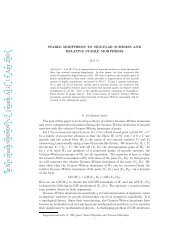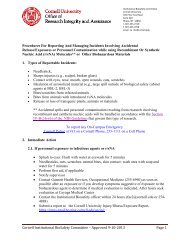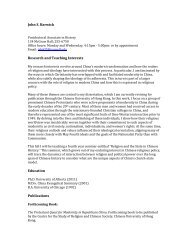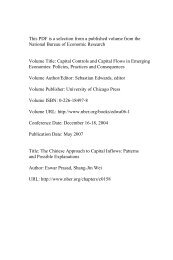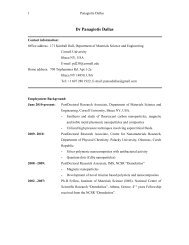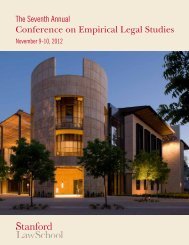Some basic results on Sturmian words
Some basic results on Sturmian words
Some basic results on Sturmian words
Create successful ePaper yourself
Turn your PDF publications into a flip-book with our unique Google optimized e-Paper software.
Uniform Density Binary Words<br />
Li<strong>on</strong>el Levine<br />
September, 2000<br />
Given a finite binary word a = a 1 . . . a n and an irrati<strong>on</strong>al number α ∈<br />
[0, 1], we say that a has uniform density α if<br />
⌊(s − r)α⌋ ≤<br />
s∑<br />
i=r+1<br />
a i ≤ ⌈(s − r)α⌉<br />
for all 0 ≤ r < s ≤ n; in other <strong>words</strong>, the proporti<strong>on</strong> of 1’s in every subword<br />
of a is close to α. Let D α denote the set of all such <strong>words</strong>.<br />
We will see that D α is closely related to the infinite binary sequence whose<br />
n-th term is<br />
s n (α, t) = ⌊t + nα⌋ − ⌊t + (n − 1)α⌋.<br />
The <str<strong>on</strong>g>basic</str<strong>on</strong>g> relati<strong>on</strong>ship between D α and s(α, t) is the following.<br />
Theorem 1. D α is the set of all finite sub<strong>words</strong> of s(α, t).<br />
Proof. If a is a subword of s(α, t) – say it begins at the k-th place – then<br />
for any 0 ≤ r < s ≤ n we have<br />
s∑<br />
i=r+1<br />
a i = ⌊t + (k + s)α⌋ − ⌊t + (k + r)α⌋,<br />
which is the number of integers in the half-open interval (t + (k + r)α, t +<br />
(k + s)α]. This interval has length (s − r)α, so it c<strong>on</strong>tains either ⌊(s − r)α⌋<br />
or ⌈(s − r)α⌉ integers. Hence a ∈ D α .<br />
1
For the c<strong>on</strong>verse, suppose a ∈ D α . Then we need to show that a is a<br />
subword of s(α, t). Note that truncating the first k characters from s(α, t)<br />
yields s(α, t + kα). Since the fracti<strong>on</strong>al parts of the multiples of α are dense<br />
in [0, 1], it’s enough to find an interval I ⊂ [0, 1] such that for any u ∈ I, the<br />
sequence s(α, u) begins with a. Let<br />
I = ( max<br />
n<br />
m r, 1 + min<br />
n<br />
m r),<br />
r=1 r=1<br />
where m r = ∑ r<br />
i=1 a i − rα. We need to check that I is in fact an interval,<br />
i.e. that its right endpoint exceeds its left endpoint. Since a ∈ D α , for any<br />
1 ≤ r < s ≤ n we have<br />
m s − m r =<br />
s∑<br />
i=r+1<br />
a i − (s − r)α < 1,<br />
so the min and max differ by less than 1 as desired.<br />
Finally, let’s check that s(α, u) begins with a for all u ∈ I. If u ∈ I, then<br />
m r ≤ u < 1 + m r for every r = 1, . . . , n. Hence<br />
r∑<br />
r∑<br />
a i ≤ u + rα < 1 + a i ;<br />
i=1<br />
i=1<br />
in other <strong>words</strong>, there is an integer between u + (r − 1)α and u + rα if and<br />
<strong>on</strong>ly if a r = 1. Thus s r (α, u) = a r , r = 1, . . . , n. This completes the proof.<br />
Corollary 1. If a ∈ D α , it occurs not just <strong>on</strong>ce, but infinitely many<br />
times in s(α, t).<br />
Proof. Wherever a occurs in s(α, t) – say it ends at the k-th place – we<br />
can substitute t + kα for t in the theorem to get a later occurrence of a.<br />
Corollary 2. If a 1 . . .a n ∈ D α , then a 1 . . .a n 0 ∈ D α or a 1 . . .a n 1 ∈ D α .<br />
Proof. If a 1 . . .a n ∈ D α , then it occurs somewhere in s(α, t), where it is<br />
followed either by a 0 or a 1.<br />
While Theorem 1 gives an equivalent descripti<strong>on</strong> of D α , it doesn’t provide<br />
any means of c<strong>on</strong>structing <strong>words</strong> of uniform density. For a more direct<br />
approach, we can arrange the elements of D α in a tree (Figure 1).<br />
2
0 1<br />
01 10 11<br />
011 101 110 111<br />
0110 0111 1011 1101 1110<br />
01101 01110 10110 10111<br />
11011 11101<br />
011011 011101 101101 101110 110110 110111 111011<br />
0110110 0110111 0111011 1011011 1011101 1101101 1101110 1110110<br />
Figure 1: Words of uniform density √ 2/2 of length ≤ 7<br />
We draw a branch from word a down to word b if b can be obtained<br />
by appending either 0 or 1 to a. By Corollary 2 above, this tree has no<br />
terminating branches. Thus each word a 1 . . . a n in the tree is the top node<br />
of either <strong>on</strong>e or two branches accordingly as <strong>on</strong>e or both of a 1 . . .a n 0 and<br />
a 1 . . .a n 1 are in D α . If a is the top node of two branches, call it a “splitter.”<br />
From Figure 1 we see that when α = √ 2/2, the first few splitters are<br />
1, 11, 011, 1011, 11011, 011011, . . .<br />
If we understand where the splitters occur in the tree, then we understand<br />
the whole tree. First of all, notice that there is at most <strong>on</strong>e splitter<br />
of each length. This is certainly true for length zero; suppose it fails for the<br />
first time at length n. Then there is a splitter of length n − 1 (just truncate<br />
the first character from any splitter of length n) and it’s unique. Call it<br />
a 1 . . .a n−1 . Then the <strong>on</strong>ly possibilities for splitters of length n are 0a 1 . . . a n−1<br />
and 1a 1 . . .a n−1 . But these can’t both be splitters, else 0a 1 . . .a n−1 0 and<br />
1a 1 . . .a n−1 1 would both be in D α , which is impossible.<br />
3
We’ll show that in fact there’s exactly <strong>on</strong>e splitter of each length. Since<br />
a 1 . . .a n is a splitter whenever a 0 a 1 . . .a n is, this means there is an infinite<br />
binary sequence f 1 , f 2 , . . . such that for each n, the unique splitter of length<br />
n has the form f n f n−1 . . . f 1 . So the questi<strong>on</strong> is, what’s this mystery sequence<br />
f As it turns out, the answer is sitting right in fr<strong>on</strong>t of us. In this c<strong>on</strong>text,<br />
what’s the most natural infinite binary sequence we can think of Well, let’s<br />
try s(α, t). But for what value of t What’s the most natural real number<br />
we can think of Well, how about α That’s right, this mystery sequence<br />
f is n<strong>on</strong>e other than s(α, α)! In less dramatic terms, that’s s(α, 0) with the<br />
initial 0 truncated. Thus<br />
Theorem 2. For each positive integer n, there is exactly <strong>on</strong>e splitter of<br />
length n, namely s n+1 (α, 0)s n (α, 0)...s 2 (α, 0).<br />
Proof. Since we’ve already shown that there is at most <strong>on</strong>e splitter of<br />
length n, we need <strong>on</strong>ly show that s n+1 (α, 0)s n (α, 0)... s 2 (α, 0) is in fact a<br />
splitter. To do this, choose ǫ > 0 small enough so that s(α, 0) and s(α, 1 −ǫ)<br />
coincide to the first n + 1 places, excluding the first place. Note that for<br />
sufficiently small ǫ, they do not coincide at the first place: s 1 (α, 0) = 0, while<br />
s 1 (α, 1−ǫ) = 1. By Theorem 1, this means that both 0s 2 (α, 0)...s n (α, 0)s n+1 (α, 0)<br />
and 1s 2 (α, 0)...s n (α, 0)s n+1 (α, 0) are in D α . Since D α is preserved under reversal,<br />
s n+1 (α, 0)s n (α, 0)... s 2 (α, 0) is a splitter.<br />
As trivial as it seems, truncating the initial 0 from s(α, 0) is in some<br />
strange way the key to the proof.<br />
Since there’s exactly <strong>on</strong>e splitter of each length, the number of <strong>words</strong> of<br />
length n in D α is always <strong>on</strong>e more than the number of <strong>words</strong> of length n −1,<br />
which gives us the following rather counterintuitive result.<br />
Corollary. The number of <strong>words</strong> of length n in D α is n+1, independent<br />
of α.<br />
What is the significance of these <str<strong>on</strong>g>results</str<strong>on</strong>g> In some sense, the sequence<br />
s(α, 0) (or, if you like, s(α, α)) tells us everything we could ever want to<br />
know about D α . Not <strong>on</strong>ly does it describe D α as a set (Theorem 1), it also<br />
encodes the complete structure of D α as a tree (Theorem 2).<br />
4
We c<strong>on</strong>clude with some questi<strong>on</strong>s that deserve further thought. Given<br />
real numbers α 1 , . . . , α n > 0 with ∑ n<br />
i=1 α i = 1, we can say that an n-ary<br />
word a 1 . . . a m has uniform density (α 1 , . . ., α n ) if<br />
⌊(s − r)α k ⌋ ≤ |{r < i ≤ s : a i = k}| ≤ ⌈(s − r)α k ⌉<br />
for all 0 ≤ r < s ≤ m and all k = 1, . . ., n. Can we classify such sequences<br />
In particular, what is the n-ary counterpart to the sequence s(α, t)<br />
To make this questi<strong>on</strong> a little more precise, we can say that an infinite<br />
binary sequence has uniform density α if all of its finite sub<strong>words</strong> do. Let<br />
U α be the space of all such sequences, with the topology induced by the<br />
lexicographic ordering. Call two sequences in U α equivalent if they agree in<br />
all but finitely many places, and let V α be the corresp<strong>on</strong>ding quotient space.<br />
Then by an argument similar to that used in the proof of Theorem 1, it can<br />
be shown that up to equivalence, the infinite binary sequences of uniform<br />
density α are precisely the sequences s(α, t), 0 ≤ t < 1. Thus the space V α<br />
is homeomorphic to the circle S 1 . What is the analogous parameterizati<strong>on</strong><br />
for n-ary sequences<br />
5




